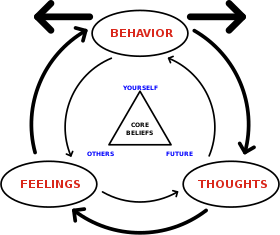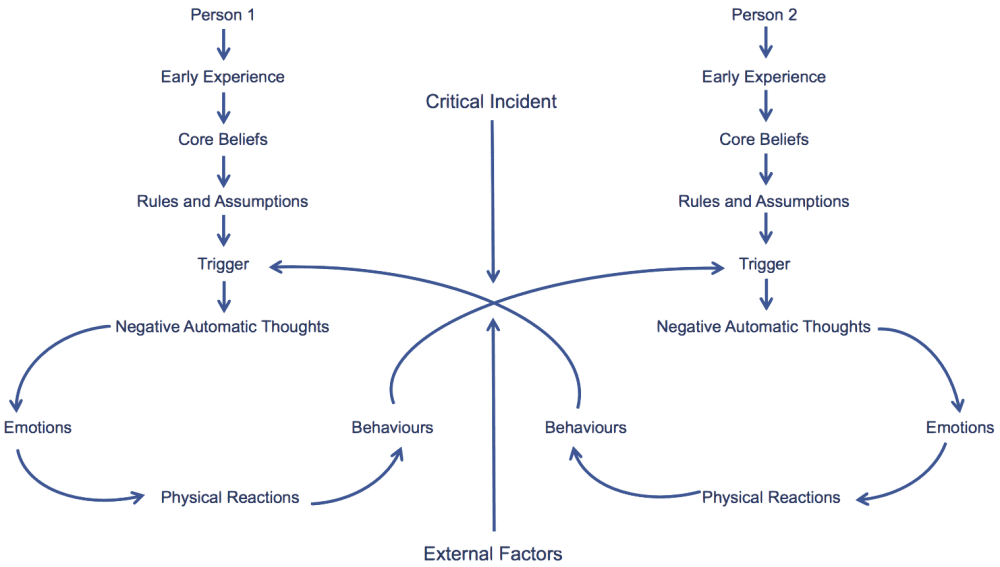A Goal of Family Therapy Is to ______.
- Cognitive Behavioral Therapy (CBT)
-
Cognitive Behavioral Therapy (CBT) has been shown to be an effective method for improving mental wellness and quality of life for concerns ranging from generalized anxiety to depression to eating disorders and more than serious concerns.Unlike other forms of therapy, CBT focuses on the "correct at present," rather than deep-diving into the cause of the problem. It helps clients to recognize their own unproductive thoughts and behaviors in the moment and provides methods to change them.
CBT allows for self-reflection and self-correction.
Core Principles
Psychological problems are, at to the lowest degree in part, due to:
- Unhelpful ways of thinking
- Unhelpful learned behaviors

Core Goals
- Decrease and manage symptoms of presenting business
- Decrease and supervene upon unhelpful ways of thinking
- Decrease and replace unhelpful behaviors
- Develop effective coping methods
- Resolve relationship conflicts
- Cope with grief/loss
- And more…
Mutual Strategies
- Learn to recognize perception distortions, and reevaluate in the context of reality
- Empathize behaviors and motivations of others
- Develop confidence in cocky
- Arrange problem-solving skills to difficult situations
- Face up fears
- Use role playing to set up for upcoming situations
- Use techniques to calm mind and torso
CBT has been supported in both psychological inquiry and clinical practise, and has been found to be every bit or more helpful than comparable techniques and medications.
Couples and families are oft concerned virtually starting counseling due to the potential for revealing relationship impairment, thus causing "distress."
Re-establishing security may require confronting unpleasant emotions or situations, withal more than often than not the problems stem from ane person "jumping to conclusions" about how others feel.
CBT helps couples and families find:
1. If and how each person jumps to conclusions (even without realizing it)
two. How the couple/family unit communicates
3. How you and your family's beliefs impacts others
iv. How prior experiences may influence negative thoughts
five. How those negative thoughts influence behavior
half dozen. How the influenced behavior impacts the partner/family
Source
Source
Source
Image Source i
Image Source two - Cognitive Behavioral Therapy Plus (CBT+)
-
Cognitive Behavioral Therapy Plus (CBT+) is an integration of multiple therapeutic techniques, specifically:
Cognitive Behavioral Therapy (CBT)
Acceptance and Delivery Therapy (ACT)
Compassion Focused Therapy (CFT)
Dialectical Behavior Therapy (DBT)All of these therapies are evidence-based and emphasize approaching problems from different perspectives.
CBT+ allows for a broader view of the presenting business organisation, and incorporates real-earth problems into the framework. For example, CBT+ integrates concerns such as poverty, racism, and marginalization into the arroyo to treatment.
CBT+ also adds a stronger accent to relationships and dives further into the history of the customer.
Source
Source
Source - Trauma-Focused Cognitive Behavioral Therapy
-
Trauma-Focused Cognitive Behavioral Therapy (TF-CBT) is an evidence-based, modified form of CBT which is specifically designed to help children and their parents overcome the negative and frequently devastating effects of trauma, specially PTSD symptoms.Taking a trauma-informed approach to family therapy can help parents larn optimal ways to support their child and the skills their child is learning in therapy. It also teaches parents effective parenting skills associated with dealing with behaviors that accompany trauma. Improvements developed by TF-CBT have been shown to be long term – parental emotional distress, child'south feet, and related symptoms still showed improvement one and 2 years after completing therapy.
Trauma may be caused by:
Sexual or physical abuse
Traumatic loss of a loved 1
Exposure to violence – domestic, schoolhouse, customs
Exposure to disaster – weather, terrorist attacks, war
Serious accidents
Serious medical procedures, operations, or hospitalizations
And more than…TF-CBT tin can aid develop skills such as:
Stress management
Bear upon regulation
Problem solving
Safety
Advice
Self-esteem empowerment
Interpersonal trustTF-CBT can address concerns including:
PTSD
Depressive symptoms
Behavioral concerns
Cerebral distortions
Guilt
Shame
Interpersonal conflict
Internalization of feelingsTF-CBT tin can be helpful for kids ages 3-eighteen and their families. This approach tin can also exist used to help couples and individuals overcome trauma. TF-CBT is tailored to each kid and family unit to be developmentally appropriate and conducive to each situation.
TF-CBT arroyo has 3 core stages of therapy, Stabilization, Trauma Narrative, and Integration/Consolidation. Each of these stages are broken down into private steps. The acronym of these steps is Practice.
Stabilization
P – Psycho-Pedagogy and Parenting Skills
The therapist helps the family larn well-nigh trauma, PTSD, common behavioral concerns associated with trauma, and validation of feelings.
R – Relaxation Skills
Learning relaxation skills helps reverse physiological effects caused by trauma, and includes a diverseness of techniques such as mindfulness, progressive musculus relaxation, and focused animate.
A – Affective Regulation Skills
Affective regulation skills help each member of the family to recognize upsetting states and learn to manage their feelings. This includes developing problem-solving, anger management, and positive distraction skills. Information technology's also a time for the family to build trust and work toward emotional safety.
C – Cerebral Processing Skills
Cognitive processing skills help each individual connect thoughts, feelings, and behaviors and replace unhelpful thoughts and behaviors with benign ones (as in CBT). Cerebral processing poses two key questions: Is it accurate? Is it helpful?
This process allows each participant to create a "window of tolerance" for communicating nearly trauma. One time both feeling and thinking are within a tolerable range and the family unit members are present and trying, and then trauma can begin to be candy.two. Trauma Narrative
T – Trauma Narration and Processing
Creating a trauma narrative is a key component to processing a traumatic issue, and it includes the telling of the individual's story – the who, what, when, where and associated emotions with each component. Creating a comprehensive narrative is oft hard and deeply emotional, but is a core step in understanding where you have been and how to move forward. Once the trauma narrative is complete, each person can contribute their narrative and brainstorm to understand how the trauma impacts their shared experience.
three. Integration and Consolidation
I – In Vivo Mastery of Trauma Reminders
In life trauma reminders often crusade psychological and/or physiological responses. This step helps to recognize the stimuli that crusade the trauma response, and larn how to overcome avoiding these reminders and cope with them equally they sally.
C – Conjoint Child-Caregiver Sessions
Sessions with the family assistance to develop communication well-nigh the trauma and moving forward. This footstep is a fourth dimension to accost topics such as condom plans and trauma responses.
E – Enhancing Safe
The concluding step is to apply the processing and coping skills and positive insights to current life and your life moving frontwards. It helps create a comprehensive toolbox of strategies and reminders to handle trauma, stress, and conflict moving forward including co-regulation of emotions and strategies for finding solutions based in emotional support and understanding.
Source
Source
Source
- Co-Parenting
-
It is well documented that the almost damage to children during and later a divorce is how parents handle themselves and their interactions with each other, non the divorce itself.
Co-parent therapy is designed to help divorced or separated parents work together to all-time meet the needs of the kid(ren). Even when the parents aren't together, kids still need love and support – this can become interrupted by emotions from the breakup and divorce procedure.
The relationship between co-parents can have a potent impact on the emotional and mental development and wellbeing of the children. Co-parenting therapy helps parents learn how to develop a new cordial, working human relationship to best support the kids.
It helps both parents take an agile role in child rearing, problem-solving, and decision-making, and can assist eliminate dysfunctional, emotionally-charged interactions.
Co-Parenting therapy helps teach both parents how to:
- Cooperate: Exchange data about the child(ren), support and respect the other every bit a parent, and divide the labor of childrearing.
- Minimize conflict: Limit undermining, criticism, and arraign toward the other parent, also every bit minimizing arguments/fights well-nigh childrearing.
- Triangulate: Develop the child(ren)'s relationship with each parent individually, while fugitive their involvement in parental conflicts. This includes avoiding:
- Using the child(ren) equally messengers to the other parent.
- Venting to the child(ren) about the other parent.
- Making the child(ren) experience like they have to cull between parents.
- Communicate with a child-centered approach:
- Split the anger, resentment, and hurt from the relationship with the other parent in social club to prioritize the child(ren).
- Treat co-parenting equally a business organization-like partnership. This allows conversations to exist focused on what'southward important whether in-person, on the phone, or through email/text.
- Go along all conversations focused on the child(ren)'s needs, non yours or your ex-partner's.
- Make requests of the other parent, non demands.
- Listen to the other parent. Listening is specially important in co-parenting in order to minimize conflict and prioritize the child(ren)'southward wellbeing.
Documented Benefits of Co-Parenting for Children
Children of all ages with parents who take adopted co-parenting practices have been shown to have:
Pregnant improvements in:
-Internalization of symptoms – Ex. Beingness withdrawn, nervous, or irritable, feeling lonely, sad, unwanted, or unloved, etc.
-Externalization of symptoms – Ex. Acting out, lying, breaking rules/laws, showing disregard for others, disobedience, and/or vindictiveness, etc.
-Social operation skills
-Attachment-Comeback in mental and emotional health
-Noesis that they (the children) are more of import than the conflict that ended the marriage
-Feelings of security
-Consistency between households leading to better adjustment
-Improved development of problem-solving and communication skillsToddlers with co-parenting parents show increased compliance and decreased aggression compared to those who do not.
Depression parental cooperation has been linked with passivity, issues with attention, and lower math grades of 3rd course students.
Additionally, it has been shown to negatively impact the child's relationship to each of their parents, and increase negative behavior toward each parent.
It also may be a gene in hating behavior in children.
Source
SourcePlease note that co-parenting therapy is relational and therefore volition not exist covered by insurance. For cash pay rates, please telephone call the function. - Eating Psychology
-
Eating Psychology Coaching is an heady and cut edge approach developed by the Institute for the Psychology of Eating.
It effectively addresses concerns including:
Weight concerns
Binge eating
Emotional eating
Overeating
Body image challenges
Various nutrition related health concernsOftentimes, our eating challenges are connected to piece of work, money, relationships, family, intimacy, life stress, and so much more.
According to the Institute for the Psychology of Eating – In America:
- Virtually 70% of adults are classified as overweight or obese
- ~90% of women are unhappy with their appearance
- 81% of 10 twelvemonth old girls experience a fear of being fat
- 97% of women confess they have at least 1 "I hate my body moment" each day
- ~75% of all diseases could be prevented with better nutrition
- ~108 million individuals are on a diet
- 99% of those who diet proceeds dorsum the weight they lose within a yr
- Within a decade, 67% of the population is projected to take some class of diabetes
Source
Eating Psychology coaches are able to support you with both strategies and diet principles. The strategies provided are doable, sustainable, and nourishing and, about importantly, yield results.
For eating psychology articles, look here.
- Dialectical Behavior Therapy (DBT)
-
Please meet our Dialectical Behavior Therapy (DBT) page here.
- Perinatal
-
Please see our Flower – Maternal and Family unit Planning Therapy page hither.
- Pride Program
-
Please encounter our Pride Program and Resilience Group page hither.
Source: https://integratedtherapynw.com/who-we-serve/family-therapy/
0 Response to "A Goal of Family Therapy Is to ______."
Post a Comment